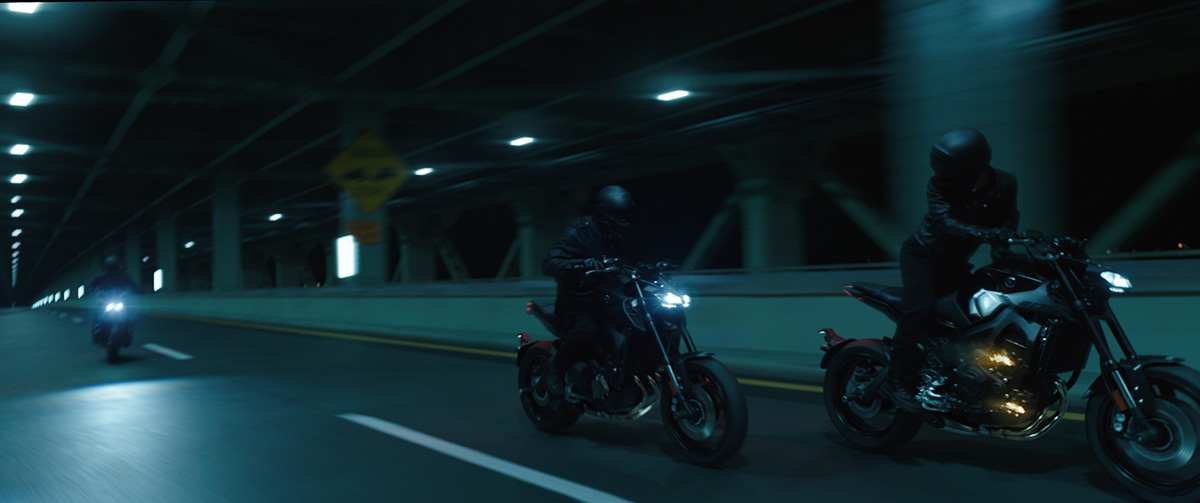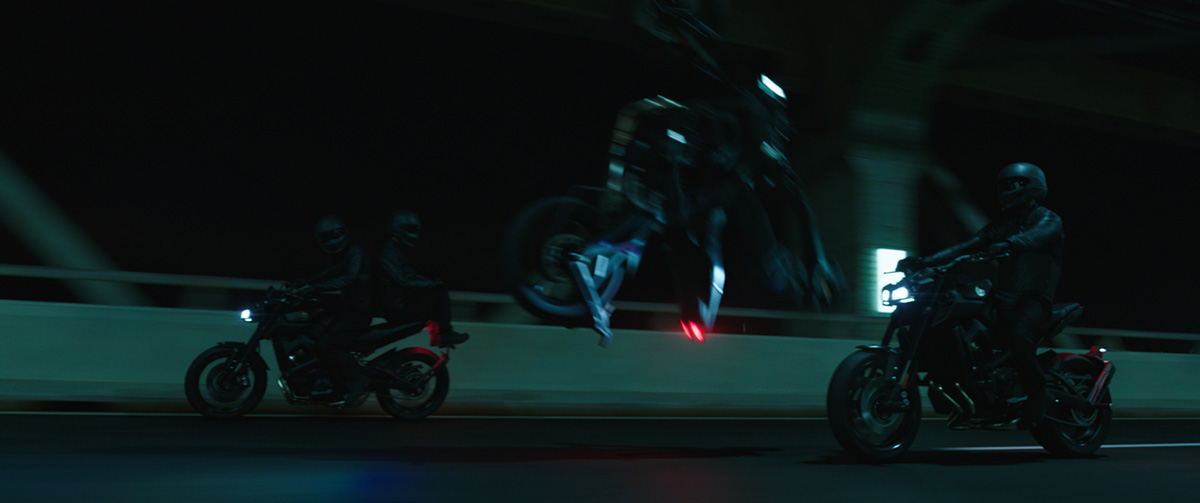Inspired by a similar dynamic sequence in South Korean movie The Villainess, the wild bike chase in John Wick: Chapter 3 – Parabellum stepped things up an extra level, with the camera moving around in between bikes and riders as they use their weapons.
Now, when your bike chase features Keanu Reeves taking on a gang of sword-wielding bad guys along the Verrazano Bridge in New York, at night, you know you’re in for some significant planning.
But just how much planning was something even production visual effects supervisor Rob Nederhorst didn’t necessarily anticipate when that scene was imagined for the film?
“That sequence was rehearsed four times before it was actually photographed for real,” relates Nederhorst. “It was a crazy amount of work.”


Rehearsal, rehearsal, rehearsal, rehearsal
Live-action for the sequence would ultimately be filmed predominantly on greenscreen, with actors and stunt performers puppeteered on bike sled rigs. Image Engine then composited that footage into background plates of the bridge, as well as generating completely CG bikes, riders and bridge sections for the shots.
But before that live action shoot was undertaken, the choreography was first worked out in a stunt space at a warehouse in New York. It was a way of testing out the moves of the bikes as well as a free-floating camera used to capture the action.


On visiting that stunt space, however, Nederhorst noticed some markings had been placed on the floor to identify bridge lanes and lane lines. “Something didn’t feel right. I said, ‘Hey guys, how wide are these lane lines?’ They told me the number and I said, ‘Is that what the actual Verrazano Bridge lane lines are? Have you measured them?’ They thought these things were all standard, but I said I needed to send someone over there to the bridge to check.’”
So Nederhorst sent lidar supervisor John Ashby to scan a piece of the Verrazano Bridge. “We had John do exact measurements of things like the distance between the lanes, all the stanchion areas, where the center divider is and how wide each lane was. And it turns out that the measurements that they had been given were wrong.”


That meant the initial choreography of the bike chase was off by about a foot and a half, notes Nederhorst. Over three lanes of traffic, the error increased. So, it was done a new time with the new measurements.
Then, to test the methodology behind the approach (ie. puppeteering of the bike rigs), another rehearsal was arranged on a stage which had, in Nederhorst’s words, “some janky janky greenscreens. But it was perfect for what we needed. We put tracking markers up and shot the whole thing again.”


The team used a Sony A7 to film this rehearsal, with Ashby then putting together slap comps on a Flame. Backgrounds came from shooting several angles on the bridge as interim plates. Notes Nederhorst: “The idea was to say, ‘Will this work? Is it cool?’ And the answer was, ‘Oh yeah, it’s pretty cool.’ It did show up a few issues with the choreography, so we filmed it a fourth time, and then comp’d that and it all looked great.”
At this point, the sequence was filmed for production, with Reeves peforming scenes and the stunt team both on bikes and dressed in green leotards. This was done at a different stage with more space and elaborate greenscreen construction – 10 to 15 feet of it on all sides.


The stunties and puppeteers were covered in green for obvious purposes; they would be removed later in comp. “We had to do something to try to help get rid of them,” says Nederhorst. “I mean, it was never going to be easy to get rid of those dudes. It was just a shit-load of paint work for Image Engine. But if we didn’t do the green people, otherwise we’d be literally painting out people wearing jeans and shoes and all that stuff. It would have been way, way bigger nightmare than it already was.”
Extraction, CG and lens flares
For Image Engine, the two main challenges of taking that greenscreen footage and compositing it into bridge plates were shot length and dynamic lighting. “Most plates were 200-300+ frames long,” notes Image Engine visual effects supervisor Christian Irles.
“The greenscreen stage was lit to match the stunt drivers driving on the practical Verrazzano Bridge at 100km/h which meant lighting changed almost every single frame. Alongside this, the camera was constantly in motion, and the bikes moved around by the puppeteers had their lights on, causing intermittent flaring. Extraction of actors and bikes was a laborious task for sure!”


CG bikes and riders were also necessary. Image Engine built John Wick’s head for face replacement shots, a rider with texture variation, one sword and a construction sign with the wording ‘BRIDGE CLOSED’.
“The bike asset and John Wick’s digi-double – which was full body – were provided by production,” says Irles. “Both of these were ingested, rigged in Maya and shaded using Gaffer. As the shots evolved and the camera kept getting closer and closer to the action, we had to add more detail to the bike’s textures.”


A stand-out Image Engine shot includes digital stunt crash animation. These were crafted to match stunt crashes that had been filmed on Verrazzano Bridge using dummies. Says Irles: “We roto-animated practical bikes and dummies as our starting point, and then did subtle enhancements so digital riders looked alive prior to the crash, and whenever possible, made the crashes themselves have more punch. To top it all off, we then simulated lots of bike FX debris and sparks to increase the sense of carnage and chaos.”
Elaborate lidar scans, measurements and photographic reference of Verrazzano Bridge were undertaken, with Image Engine required to build a CG version of the environment that would precisely match the real one.


“We modeled the CG bridge referencing the lidar to make sure all proportions were correct,” outlines Irles. “However, due to shot durations and speed at which bikes and camera were travelling, we had to build our bridge in sections so we could make it shorter or longer on a per-shot basis. Bridge texturing was achieved using both texture photography provided by production, and procedural maps.
“Last but not least, we shaded and lit our bridge in shot context. We match moved a practical plate of Verrazzano Bridge and used that camera to render our digital environment. As its lighting and shading progressed, we constantly compared it against the practical Verrazzano Bridge plate until the point where we couldn’t tell them apart.”
Irles says things like lens flares helped sell the final shots; these were closely matched to the practical anamorphic lens photography. “During the greenscreen beats,” the VFX supervisor details, “we had to make sure everything related to the lens – i.e. depth of field, bokeh kernel, black levels, highlights, chromatic aberration and lens flares – matched the practical Verrazzano Bridge plates perfectly.”
“We also introduced additional hand held camera movement and applied high frequency camera shake to mimic road vibration,” adds Irles. “Dynamically fluctuating the overall exposure also helped. One last little item that really helped foreground / background integration was adding light spill from CG bridge lights onto foreground actors.”



















And still. If youre driving and something gets stuck in your back wheel. You dont fly backwards with the whole bike. LMAO.
John Wick 3 was wicked. Loved it!